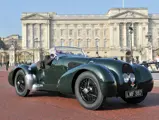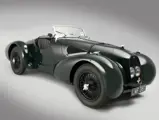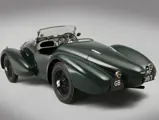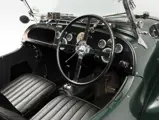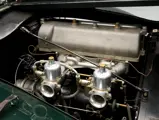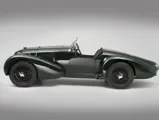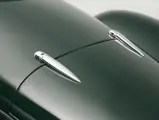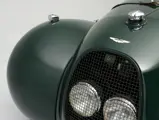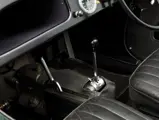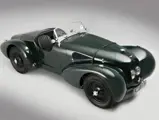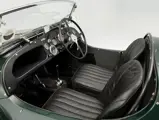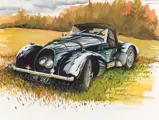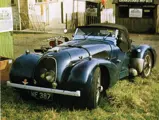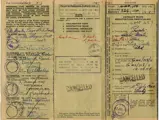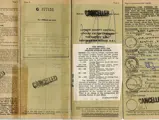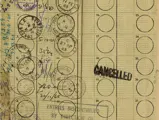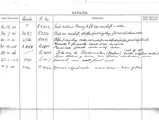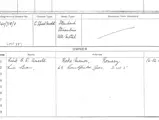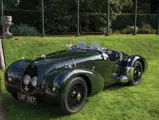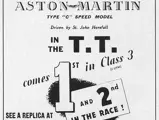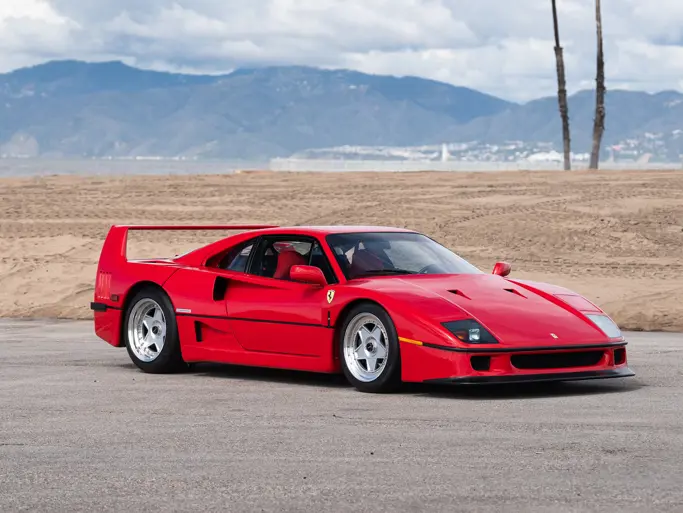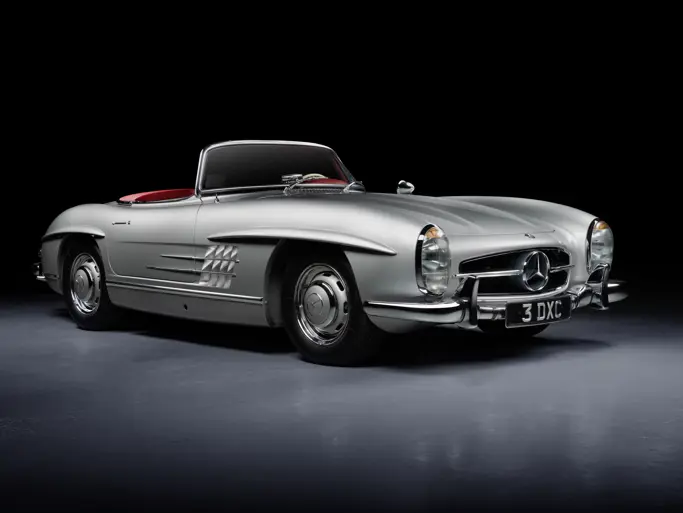Monterey 2015
1940 Aston Martin Speed Model Type C
{{lr.item.text}}
$1,155,000 USD | Sold
 | Monterey, California
| Monterey, California
{{internetCurrentBid}}
{{internetTimeLeft}}

- One of 23 full competition-specification Speed Models produced
- One of only eight Type C versions
- Believed to be the final Aston Martin delivered during WWII
- International concours participant; extreme originality of components
- Very fast, with a striking, aerodynamic design
125 bhp, 1,949 cc SOHC inline four-cylinder engine with twin SU carburetors, four-speed manual transmission, front and rear live-axle suspension, and four-wheel Lockheed hydraulic drum brakes. Wheelbase: 102 in.
By the mid-1930s, Aston Martin was indeed one of the most admired of British sporting marques, now under the design and technical direction of Augustus “Bert” Bertelli. Undeniably pretty, they were purposeful, solidly engineered, hand-built, quick, and agile.
In early 1936, a new engine, funded by a £10,000 injection of capital by Sir Arthur Sutherland, was being developed by the company’s brilliant young engineer, Claude Hill. Two liters in capacity, it was producing about 25 percent more power than the previous 1½-liter engine. This 2-liter was a completely new unit, with larger 1⅝-inch carburetors. higher lift cams, and importantly, fitted with a dry sump. These Works engines eventually produced 125 brake horsepower, so encouraging in fact that the decision was taken to design a new chassis into which it could be fitted. This was to become the legendary Speed Model, the first two purpose-built in 1936 to uphold the extraordinary successes for Aston Martin at Le Mans in 1934 and 1935.
The new chassis was even stronger than that of its predecessor, the mighty Mark II Le Mans. The wheelbase was one inch shorter than the earlier 1½-liter cars, but the track was two inches wider. The advanced hydraulic brake system by Lockheed was in effect two separate circuits, front and rear, with built-in redundancy for safety. The cost was enormous, allegedly almost 15 percent that of the whole car. However, it did work superbly well, and few cars with drum brakes, right up to the advent of discs, had better braking than a Speed Model Aston Martin.
In addition to the new engine, an entirely new gearbox was developed. Easily capable of handling 200 brake horsepower, and with close ratios and constant mesh gears on the input and main shafts (the ratios of which could easily be changed to lengthen or shorten the intermediate gear ratios), it was one of the finest pieces of engineering to come out of the pre-war Aston Martin factory. While other manufacturers were developing synchromesh gearboxes, Bertelli and Hill understood that all racers needed to do was get into the next gear as quickly as possible. Publicity materials featured the “racing type gearbox, designed for lightning changes up or down,” and one of the joys of driving a good Speed Model remains, to this day, mastering its rewarding gearbox.
Sadly, the planned entry in the 1936 24 Hours of Le Mans race did not take place due to a labor action by French workers, so the two factory team cars were quickly sold to defray the costs of development. However, work did progress on more than half of the remaining chassis required to homologate the car for Le Mans. These had a mix of coachwork styles, as, for the first time, there was not a single readily recognizable body for a production Aston Martin. The last eight cars to be assembled, late in 1939 and into 1940, had very unusual steel-framed bodies designed by Claude Hill (the “Type C”), with a real emphasis on aerodynamic efficiency.
They were considered unusual, even extravagant given the full competition specification, with a broad yet flowing nose and long tapering tails with sleek wings fully enclosing the wheels. The main body panels were constructed of light alloy and the wings from steel. First introduced to the public at the 1938 Earls Court Motor Show, the final iteration of this design featured the headlamps dramatically set behind the rounded radiator shell. They were nearly 20 mph faster than the open-wheeled and 2/4-seater bodied cars, almost certainly as a result of their wind-cheating shape. In fact, in its first competitive event at the Donnington Tourist Trophy race, the Type C earned a 1st in class (2nd OA) with ace Aston pilot St. John Horsfall at the wheel.
CHASSIS NUMBER 718
Chassis number 718 is believed to have been the last Aston Martin sold prior to the end of World War II, having left the Works just prior to Christmas 1940. Factory records note service history through 1950, with the original owner, Mr. Ansell of Romsey, using the car in the Brighton Speed Trials of 1946. Sometime after, the car was sold to a Miss Bean, of London, who is documented as having participated with the car in the AMOC Warlingham Rally in 1949, winning 1st in class.
The Speed Model was then acquired by Peter Morton Bayard Rowland, of London, in July 1955. It was sold again to John William Coles, of Surrey, in August 1960 and then, after a brief subsequent owner, to Barry Perryman in late 1962; Perryman participated with the car in the 1967 AMOC Concours, earning First in Class. In his ownership, the car was pictured in an Aston Martin article in Volume 1, Number 4 of Automobile Quarterly, showing it to remain in very good original condition.
In 1975, the Aston passed to Mark Goodson, of Kilham, Scotland, who owned the car for over a decade before passing it to Klaus Graba, of Germany, around 1989. It was then purchased by Wolfgang Friedrichs, of Dusseldorf, in November 1997. From 1998 to 2002, this long-term keeper embarked upon an extensive yet sympathetic restoration, whereupon the Speed Model was refurbished from the frame up and the body off. Great care was taken by Marksdanes Ltd. to preserve the originality of body panels, while the mechanical systems were completely overhauled by Andy Bell, including the utilization of Ecurie Bertelli’s reinforced engine block, with a nitrided steel crankshaft plus the full complement of internal engine performance upgrades offered by this esteemed pre-war Aston Martin specialist firm. The original engine block is available with the car, F.O.B. from its current location at Ecurie Bertelli, Buckinghamshire, UK.
The current owner was invited to participate with the Speed Model in the St. James’s Concours of Elegance in 2013, the only recorded public event at which it was shown since its restoration. With its perfected ownership history, it is known as one of the few Type Cs to retain its original bodywork. It is offered with its removable top, tonneau, reproduction jack and tools, copies of the original factory build sheet, period photographs, 30-plus years of correspondence from prior owners, a thick binder of restoration photos (including of the bare chassis), invoices and service records, a rare original clothbound Two-Litre Instruction Book, period brochure, and an original UK "buff" logbook. It is currently registered on its original UK number plates, LMF 387.
Today, the Speed Model has just benefited from a fresh service at Ecurie Bertelli, where it was fitted with an aluminum radiator replicating the original, and its water pump was rebuilt with fresh bearings and seals to ensure cool running.
With its striking, penultimate body design, known ownership, masterful restoration, and recent fettling, this Type C is among the most rare and desirable of all pre-war Aston Martins. One might not imagine a better way to go fast with stylish flair at top international events, such as the Goodwood Revival, or on an exhilarating blast down a country lane.

